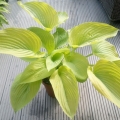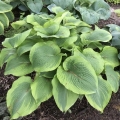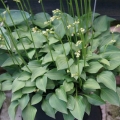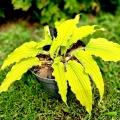Online Shop
130
Royal Horticultural Society
Gold Medals
Royal Horticultural Society
Gold Medals
- Home
- About Bowdens
- Martin Rickard
- Frond Memories by Monty Don - The Observer, Sunday 1 September 2002
Frond Memories by Monty Don - The Observer, Sunday 1 September 2002
They've always had their devotees, but now they are enjoying a new lease of life. Monty Don joins the fern fan club.
The Victorians loved ferns with a fervour. They exactly suited their simmering energy and umbrella'd horror of the sun. They built fern houses, often partially submerged and heated to create a dank tunnel of green, with the shimmering gloom of a summer's day poised on the edge of a thunderstorm. But for the past 50 years or so, ferns have been less popular, although they do have obsessively interested followers. There is a dank, reptilean quality to them that is quite alien to our modern, florid archetype of the garden. Ferns belong either to the lush tropics of the imagination or the dark nooks and shadows of an abandoned courtyard. Yet a number are well suited to urban backyards which exist in constant, very dry shade, the hardest of all conditions to cope with.
Of course, I am being slightly disingenuous. Ferns seem to be making a comeback. Wealthy urban trendies have been growing tree ferns (almost always Dicksonia antartica , although there are in fact more than 600 different species of tree fern) for the past 10 years to provide instant glamour in shady inner-city back gardens. A tree fern costs about £30 per foot, so they are hardly cheap but sales are on the up.
But I have never quite got this style of gardening. To import a plant that has no context whatsoever with the surrounding flora and fauna and to plonk it down among mown grass and bedded-out borders is like interior decoration. It is plant as lampstand. For once, I would rather be indoors and go the whole hog. The tree ferns in the Kible Palace in Glasgow, which has the largest collection in the UK, or the Botanic Gardens in Edinburgh are fantastic because these places set the ferns in context with cast iron and glass.
I have Osmunda regalis growing in our damp garden, the odd uninvited hart's-tongue, a couple of spleenworts (Aplenium scolopendrium is the common hart's-tongue but mine, I think, are a cultivar from the fimbriatum group), and an unnamed fern that has quietly been surviving in the spring garden for the past eight years without me ever bothering to discover its name. In looking through Martin Rickard's seminal Plantfinders Guide To Garden Ferns (£13.99, David & Charles), I see that it could well be Polystichum setiferum 'Plumosomultilobum'. But the truth is that it is hard to be a competent amateur with ferns.
It just so happens that Martin Rickard, the specialist's specialist, has his nursery, Rickard's Hardy Ferns, just across the border in Worcestershire, so I went to see him.
His nursery is, like all specialist's nurseries, a modest set-up, as removed from the make-over razzle of a garden centre as a senior common room is from the Big Brother House. There are four tunnels, various long, netted shade tunnels, and rows of tree ferns lining a roadway among the leylandii and birch trees. No concessions or apologies are made for its focus, which is ferns, ferns and then some more ferns. Mind you, it is set in the grounds of Kyre Park, which has 29 acres of landscaped grounds with five huge lakes that are well worth the visit. They are also filled with more than their quota of ferns because Martin used to own and live in the huge house until he got divorced, and he reclaimed and restored large tracts of the garden himself between 1993 and 1997.
Martin Rickard is an affable man. He has been besotted by ferns since studying botany on day release from his job in the early 60s. He did not start the nursery until 1989, and only gave up his day job in agro-chemicals when he moved to Kyre in 1993. He told me that at his first Chelsea Flower Show, in 1993, he was terrified that he might be caught on camera because his then employers did not know that he was devoting so much time to this other business. Fear of exposure did not stop him winning a gold medal and he has repeated the trick every year since, not to mention regular golds at Hampton Court, Tatton Park and the NEC. Shows are important to him, ostensibly for the quarter of his turnover that they provide, but also, I suspect, for the chance to display his ferns and share his enthusiasm with the gardening world at large.
He took me to The Pit which was originally an overflow for the drainage system for the big house at Kyre Park, a brick tank floored with especially porous bricks. The refuse would be spilled into this and gradually the liquids would filter through the floor leaving a layer of human waste which was dug out and spread on the kitchen garden. Martin put a roof over it and it is now a sunken barn filled with 30 different species of tree ferns. 'I'm happy in here,' Martin says. It is obvious that he really means it. They are incredibly beautiful things, fronds arching gracefully with a series of amazingly delicate overlapping shapes and filigrees from the bundle of fibrous roots that make the trunks. I have often heard people solemnly say that the trunks are all roots, but this is not the case. The core is a woody stem called a caudex which is surrounded by roots, fibre and old leaf bases. Some grow to 60ft tall. 'People don't appreciate the problem of getting these to shows,' Martin says with feeling. 'They can't be put on their sides. That's why most tree ferns at shows are small.' I notice that all the tree ferns, despite their size, are in tiny pots, hardly bigger than the trunks. This is partly because they are adapted to growing in a very thin layer of forest floor and partly because they have grown through the pots and are rooted through the bricks into the floor below.
The final twist in Martin's tale is that he is selling the nursery. His love of ferns has not diminished, but he has had enough of the relentless work. 'I want to have some time to garden and write more,' he says. But Rickard's Hardy Ferns will continue. He has organised the sale so that the name and phone number stay the same, although it will move this autumn to a new location in North Wales.
Your roots
Getting down to basics with ferns:
Unlike most plants, ferns do not have sexual organs, but need a separate generation of growth to reproduce. The fern we see and grow is actually only one part of the plant's lifecycle. This is the sporophyte, producing the tiny rusty spores that are their reproductive bodies. It has been calculated that a single fern can produce more than a billion spores. These germinate into a heart-shaped, independent plant called a prothallus, about an inch in diameter, with microscopic male and female organs which fertilise cells to form the new ferns.
Most ferns like poor soil and good drainage. A bank of some kind is ideal. Plant them in a slight depression so that the soil does not get washed away from their roots.
Aspleniums, many adiantum species, arachniodes standishii, asplenium dcolopendrium, most aryopteris, polypodiums and polystichums.
Ferns that tolerate damp: All blechnums, equisetum hyemale, cymnocarpium dropteris, oreopteris limbosperma, phegopteris connectilis.
Ferns for very damp places: Athyrium species, dryopteris cristata, matteuccia struthiopteris, osmunda species and osmunda regalis cultivars, woodwardia areolata.
The Victorians loved ferns with a fervour. They exactly suited their simmering energy and umbrella'd horror of the sun. They built fern houses, often partially submerged and heated to create a dank tunnel of green, with the shimmering gloom of a summer's day poised on the edge of a thunderstorm. But for the past 50 years or so, ferns have been less popular, although they do have obsessively interested followers. There is a dank, reptilean quality to them that is quite alien to our modern, florid archetype of the garden. Ferns belong either to the lush tropics of the imagination or the dark nooks and shadows of an abandoned courtyard. Yet a number are well suited to urban backyards which exist in constant, very dry shade, the hardest of all conditions to cope with.
Of course, I am being slightly disingenuous. Ferns seem to be making a comeback. Wealthy urban trendies have been growing tree ferns (almost always Dicksonia antartica , although there are in fact more than 600 different species of tree fern) for the past 10 years to provide instant glamour in shady inner-city back gardens. A tree fern costs about £30 per foot, so they are hardly cheap but sales are on the up.
But I have never quite got this style of gardening. To import a plant that has no context whatsoever with the surrounding flora and fauna and to plonk it down among mown grass and bedded-out borders is like interior decoration. It is plant as lampstand. For once, I would rather be indoors and go the whole hog. The tree ferns in the Kible Palace in Glasgow, which has the largest collection in the UK, or the Botanic Gardens in Edinburgh are fantastic because these places set the ferns in context with cast iron and glass.
I have Osmunda regalis growing in our damp garden, the odd uninvited hart's-tongue, a couple of spleenworts (Aplenium scolopendrium is the common hart's-tongue but mine, I think, are a cultivar from the fimbriatum group), and an unnamed fern that has quietly been surviving in the spring garden for the past eight years without me ever bothering to discover its name. In looking through Martin Rickard's seminal Plantfinders Guide To Garden Ferns (£13.99, David & Charles), I see that it could well be Polystichum setiferum 'Plumosomultilobum'. But the truth is that it is hard to be a competent amateur with ferns.
It just so happens that Martin Rickard, the specialist's specialist, has his nursery, Rickard's Hardy Ferns, just across the border in Worcestershire, so I went to see him.
His nursery is, like all specialist's nurseries, a modest set-up, as removed from the make-over razzle of a garden centre as a senior common room is from the Big Brother House. There are four tunnels, various long, netted shade tunnels, and rows of tree ferns lining a roadway among the leylandii and birch trees. No concessions or apologies are made for its focus, which is ferns, ferns and then some more ferns. Mind you, it is set in the grounds of Kyre Park, which has 29 acres of landscaped grounds with five huge lakes that are well worth the visit. They are also filled with more than their quota of ferns because Martin used to own and live in the huge house until he got divorced, and he reclaimed and restored large tracts of the garden himself between 1993 and 1997.
Martin Rickard is an affable man. He has been besotted by ferns since studying botany on day release from his job in the early 60s. He did not start the nursery until 1989, and only gave up his day job in agro-chemicals when he moved to Kyre in 1993. He told me that at his first Chelsea Flower Show, in 1993, he was terrified that he might be caught on camera because his then employers did not know that he was devoting so much time to this other business. Fear of exposure did not stop him winning a gold medal and he has repeated the trick every year since, not to mention regular golds at Hampton Court, Tatton Park and the NEC. Shows are important to him, ostensibly for the quarter of his turnover that they provide, but also, I suspect, for the chance to display his ferns and share his enthusiasm with the gardening world at large.
He took me to The Pit which was originally an overflow for the drainage system for the big house at Kyre Park, a brick tank floored with especially porous bricks. The refuse would be spilled into this and gradually the liquids would filter through the floor leaving a layer of human waste which was dug out and spread on the kitchen garden. Martin put a roof over it and it is now a sunken barn filled with 30 different species of tree ferns. 'I'm happy in here,' Martin says. It is obvious that he really means it. They are incredibly beautiful things, fronds arching gracefully with a series of amazingly delicate overlapping shapes and filigrees from the bundle of fibrous roots that make the trunks. I have often heard people solemnly say that the trunks are all roots, but this is not the case. The core is a woody stem called a caudex which is surrounded by roots, fibre and old leaf bases. Some grow to 60ft tall. 'People don't appreciate the problem of getting these to shows,' Martin says with feeling. 'They can't be put on their sides. That's why most tree ferns at shows are small.' I notice that all the tree ferns, despite their size, are in tiny pots, hardly bigger than the trunks. This is partly because they are adapted to growing in a very thin layer of forest floor and partly because they have grown through the pots and are rooted through the bricks into the floor below.
The final twist in Martin's tale is that he is selling the nursery. His love of ferns has not diminished, but he has had enough of the relentless work. 'I want to have some time to garden and write more,' he says. But Rickard's Hardy Ferns will continue. He has organised the sale so that the name and phone number stay the same, although it will move this autumn to a new location in North Wales.
Your roots
Getting down to basics with ferns:
Unlike most plants, ferns do not have sexual organs, but need a separate generation of growth to reproduce. The fern we see and grow is actually only one part of the plant's lifecycle. This is the sporophyte, producing the tiny rusty spores that are their reproductive bodies. It has been calculated that a single fern can produce more than a billion spores. These germinate into a heart-shaped, independent plant called a prothallus, about an inch in diameter, with microscopic male and female organs which fertilise cells to form the new ferns.
Most ferns like poor soil and good drainage. A bank of some kind is ideal. Plant them in a slight depression so that the soil does not get washed away from their roots.
Aspleniums, many adiantum species, arachniodes standishii, asplenium dcolopendrium, most aryopteris, polypodiums and polystichums.
Ferns that tolerate damp: All blechnums, equisetum hyemale, cymnocarpium dropteris, oreopteris limbosperma, phegopteris connectilis.
Ferns for very damp places: Athyrium species, dryopteris cristata, matteuccia struthiopteris, osmunda species and osmunda regalis cultivars, woodwardia areolata.
New Additions
-
Wundergold £15.00

-
Unruly Child £14.00

-
Twin Cities £11.00

-
venusta 'Porter' £8.00

-
Valley's Love Birds £10.00





